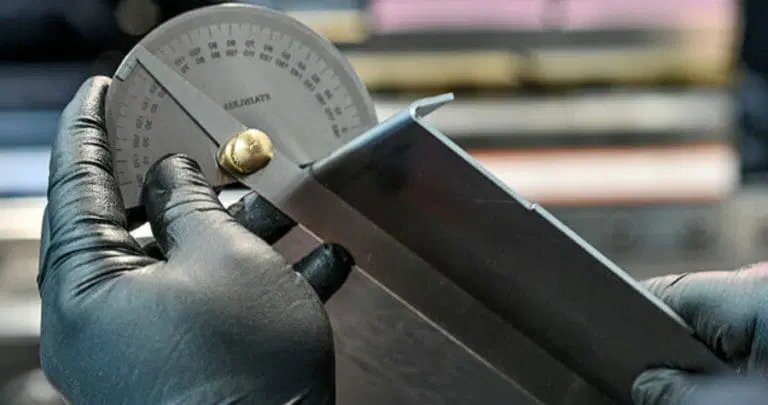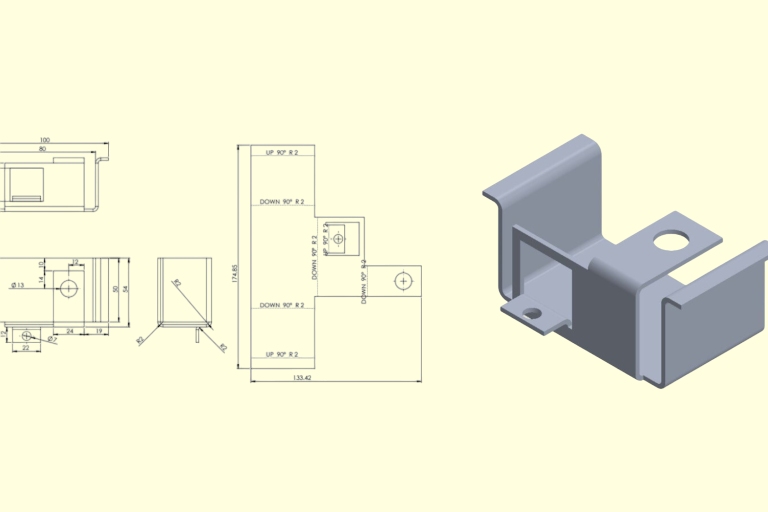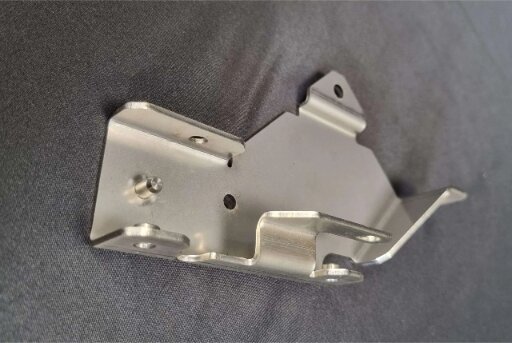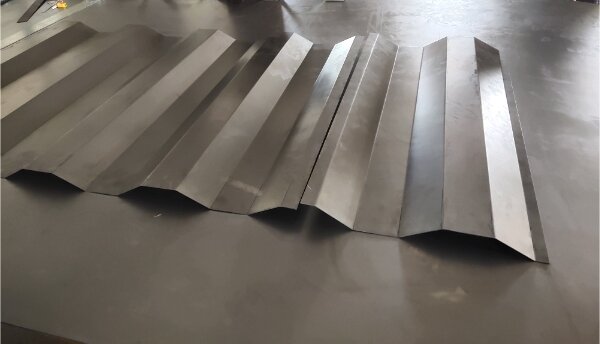When I speak with customers from around the world, the topic of the importance of surface finish for metal fabrication is a constant. As a result of countless sheet metal components shipped to several industries, I have come to understand and appreciate this vital aspect.
Surface finish is an object’s surface’s appearance, texture, and smoothness. Surface finish is crucial to determining a product’s functionality, build, and longevity. A good surface finish gives the product a polished appearance and ensures that it performs according to its intended purpose.
You may wonder why this is so important. We will delve into the complexities of surface finishing and its importance in sheet metal fabrication.
Basics of Surface Finish
Surface finishes are vital to sheet metal fabrication, especially regarding aesthetics and precision. I’d like to take you on a short but insightful journey through the essence of surface finishes and their indispensable role in manufacturing.
Definition Surface Finish
Surface finish is often used interchangeably with “surface texture” to describe the visible and physical attributes of the surface of a fabricated part. It can be a combination of topography, smoothness or roughness, and even deliberate patterns. Surface finish is not just a matter of aesthetics. It’s also a complex blend of engineering. The surface finish is determined by every ridge, valley, and undulation, whether they are intentional or not.
Surface finishes are evident in every product, from the elegant polished metal of a smartphone to the rugged exteriors of industrial machinery.
Importance of Manufacturing and Production
Why is surface finish so revered in manufacturing? Its essential role is explained:
Functional compliance: A part’s finish can directly impact its functionality. Components that must move against one another require smoother surfaces to reduce friction. Consider the necessary precision in the aerospace and automotive industries. A small mistake in surface finish could lead to significant operational issues.
Aesthetic Appearance: In a market where products are plentiful, and consumers demand, aesthetics are often the deciding factor. A superior surface can enhance the perceived value of a product. When clients like Jack Garcia choose gold-plated components, this surface finish is a symbol of class and quality.
Product Life Extension: A surface finish that is well executed can act as a protective barrier to protect the product against environmental factors like corrosion, wear, or UV damage. This directly translates into increased durability and a long lifespan.
Economic considerations: A consistent, high-quality finish often results in fewer post-production corrections. This can result in fewer rejected components, less rework, and a more streamlined process, which leads to cost savings.
Safety & Hygiene: The surface finish is not just about appearance in industries such as food processing and medical equipment manufacturing. Health is the most essential factor. Sterilization is more effective on surfaces that are smooth and non-porous.
Surface Finishes Types
Understanding the different surface finishing techniques is essential when you delve deeper into this field. Different finishes have other purposes, from the sheen of a decorative item to the durability required for an industrial component. Join us on this fascinating journey.
Mechanical Surfaces
We achieve mechanical finishes by changing an object’s surface to produce the desired finish.
Sanding
Abrasives like sandpaper and grinding wheels smoothen or coarsen a surface. This method is effective in removing imperfections and achieving a specific surface roughness. Sanding is a great way to improve adhesion before coating or painting.
Buffing & Polishing
Use soft cloth wheels and polishing agents to create a mirror-like shine, polishing, and buffing. This process removes a thin metal layer from the surface to smoothen it.
Chemical Finishes
Chemical methods include reactions that alter the surface properties of metals.
Acid Pickling
People use acid baths to remove oxide scale and rust. They often clean steel with this method before processing it further.
Passivation
The process of passivation is to treat stainless steel surfaces with acid solutions to remove any iron that may be present. It increases its corrosion resistance naturally by forming an oxide layer.
Electroplated finishes
Electroplating involves coating an object with a desired metal by dipping it into a solution containing the metal.
Chrome plating
The chrome plating finish is attractive and shiny, with a high corrosion resistance. You can commonly find chrome plating on decorative items, tools, and automotive parts.
Nickel plating
Nickel plating provides a smooth surface that protects base metals from corrosion and wear. It can improve solderability and provide a base for other plated coatings.
Coated Finishes
We coat metal surfaces to protect them or to get a specific appearance.
Powder Coating
We apply a free-flowing, dry powder to metal surfaces using an electrostatic method. It then cures under heat. This produces a durable and attractive finish that is available in many colors.
Paint Coating
You can spray or brush paint onto metal surfaces to protect them and improve their aesthetics. The paint is versatile and comes in various colors and finishes.
Comparing Surface finishes
When choosing a surface finish, it is essential to balance aesthetics, cost, and functionality. Let’s compare:
Durability vs. Lifespan – Which is Longer?
- The protection provided by electroplated finishes such as chrome and nickel makes them highly durable.
- Powder coatings are particularly resistant to scratching and chipping.
Cost Effectiveness: Get the Most Bang for Your Buck
- Sanding is a mechanical finish that can be less expensive. Still, it may provide a different level of aesthetics or protection than other methods.
- Although electroplating is more costly, it has both aesthetic and functional advantages.
Aesthetic Appeal – What looks best for different purposes?
- Buffing, polishing, and chrome plating will give you a luxurious, mirror-like finish.
- Powder coating is a great option for a sleek, modern look. It also offers countless color choices.
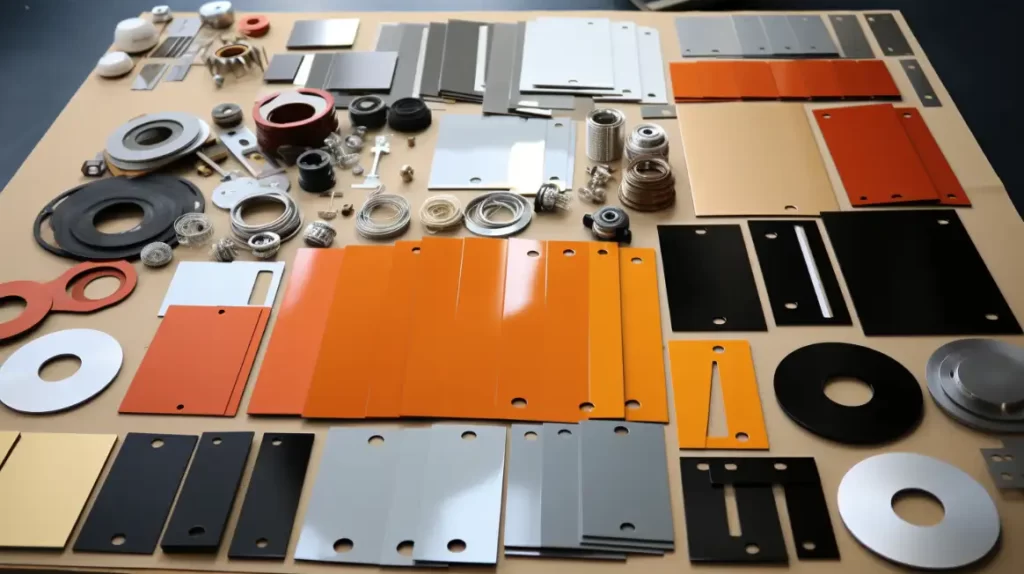
Factors Influencing Surface Finish Selection
Before we begin a project at Shengen, we conduct a thorough analysis and dialogue. I want to share some critical considerations when choosing the best surface finish.
Material properties
Finishing processes are unique to each material. Aluminum, for example, is a softer metal that may not be suited to aggressive mechanical finishes. However, it can be a good candidate for coatings. The metal’s hardness, malleability, and thermal properties can influence the choice of finish.
Functionality
Will the component be used as a static display piece or dynamically integrated into a machine? If a part faces friction, heat, or stress, chrome plating might be a suitable finish. However, an aesthetic finish could benefit decorative elements like powder coating or buffing.
Aesthetic considerations
Visual appeal is essential. Aesthetics play a significant role in the selection of surface finishes.
Environmental Factors
Where will the final product be located? Finishes that enhance protection in corrosive environments might be the best choice. For example, passivating stainless steel is a good option. UV-resistant coatings are a good option for products exposed to UV light and harsh weather conditions.
Practical applications in industries
Surface finishes are a subject of great diversity in standards and requirements.
Automotive Surface Coatings
Aesthetics and durability are critical factors in the automotive industry. Chrome plating offers both protection and a shimmering finish for bumpers and grills. Engine components are more functional and may use finishes that resist friction and heat.
Electronics and Semiconductors
People often choose electronic surface finishes for conductivity, solderability, and corrosion protection. Nickel or gold plating is widespread, providing a high-performance finish and reflecting light.
Furniture and Interior Design
The touch, feel, and visual appeal of decor are essential. To get a modern look, combine wood with powder-coated frames. Vintage designs may use brushed or polished surfaces to invoke a nostalgic feeling.
Surface Finish Measurement Techniques
Surface finish is more than just appearances. It’s also profoundly connected to texture, feel, and, often, microscopic surface topographies. How can we tell these differences apart? How can we measure something that is not measurable? Let me reveal the methods we use to ensure that every product that leaves our facility meets or exceeds all standards.
Contact methods
These methods require physical contact or touch with the surface to be measured.
Profilometer
A profilometer measures the roughness of surfaces. The device uses a stylus to move across the surface and analyze height deviations. Each measurement is unique, and each tells a story.
Surface Roughness Tester
This device, similar to a profilometer, can be used on-site for evaluations. This device measures the roughness of a surface. It provides quantitative data which can be related to specific manufacturing processes.
Non Contact Methods
You can measure surface finishes without making contact.
Optical Profilometry
A light beam maps the surface topography. The beam scans the surface, reflecting and scattering light to create a detailed map. This method is non-invasive, and it provides high-resolution images. It’s handy for characters that are polished or soft.
Laser Scanning
Laser scanning is fast and precise. They are reflected off surfaces and captured by detectors. We can determine the surface profile by measuring the time the laser beam returns. This method is suitable for comprehensive assessments because it can cover a larger area in less time.
Common mistakes in measuring surface finish
There’s always room for human error with such precise methods. Let’s look at some common pitfalls.
Inconsistent Measurement Techniques
Surface finish measurements must be consistent. Different tools and operators can produce different results. We ensure that our staff is trained regularly and receives standardized procedures at Shengen to maintain consistency.
Misinterpretation of Data
How we interpret data determines its quality. People might view a high Ra value as ‘rough’ in specific applications but want this result. Understanding the context and application of the product is essential.
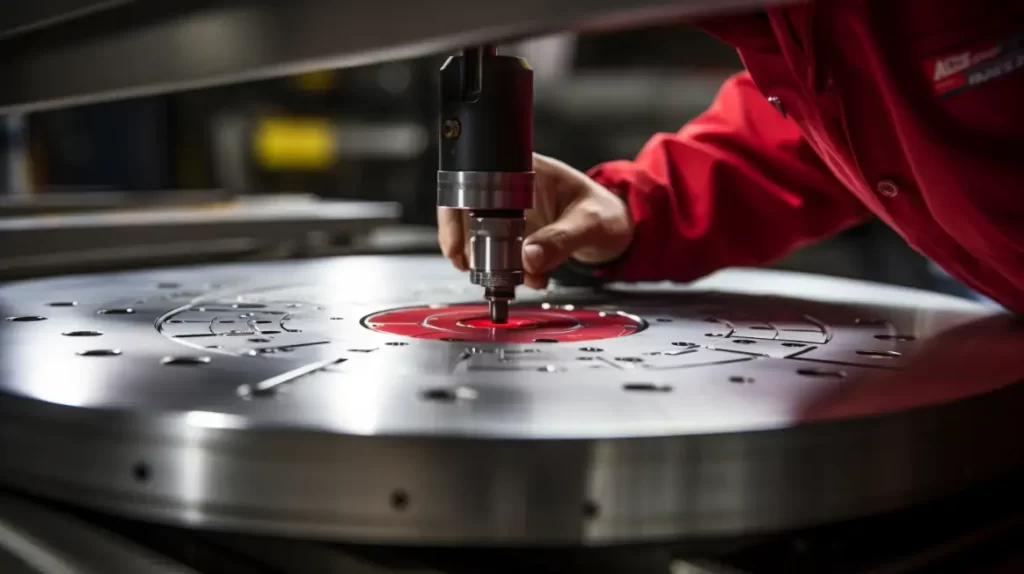
Surface Finish and Performance
How does surface finish fit into this? The surface finish protects and enhances the functionality of our products, just as the skin on our body does. Let’s explore how the finish affects performance.
Wear-and-Tear Resistant
It’s not just about the aesthetics of a finely finished surface; it’s also about durability. Surface finishes can improve wear resistance. Consider this: an automotive part with a durable finish will withstand the daily rigors on the road — stones, dust, and heat — much better than its non-finished counterpart. The finish is a protective shield that absorbs the impact and ensures the material underneath remains intact.
Corrosion Resistance
When a customer like Jack Garcia chooses our gold-plated parts, he’s not just looking for the shimmer. The platings and finishes act as barriers to the corrosive elements in the environment. They protect the metal from moisture, chemicals, and other corrosive agents, increasing lifespan. A solid surface finish will protect your product from corrosion, whether due to industrial chemicals or salty air.
Friction Reducer
Reduce friction by using smooth finishes on moving parts. This reduces wear and ensures efficient operation. Even the slightest amount of friction can cause energy loss in industries that require precision, such as aerospace and high-performance automobile applications. Surface finishes tailored to the component ensure smooth movement and optimize performance.
Surface Finishing Maintenance
No matter how hard we try, there is no perfect finish. With a bit of care and maintenance, you can extend its life.
Sealants and Protective Coatings
Protective coatings and sealants are the best way to protect your product from environmental aggressors once it has reached the perfect finish. They act as a protective layer that protects the product from environmental aggressors.
Tips for Cleaning and Maintenance
Regular cleaning makes a huge difference. It is essential to use the correct cleaning techniques and agents. Always use soft cloths with mild detergents. Abrasive materials may damage specific finishes. Periodic inspections will also allow you to catch minor problems before they become major.
Concerns about the Environment and Sustainability
We know that manufacturing can have an environmental impact, particularly in our field. We are adamant that industry can and should tread lightly on the Earth. We’ll explore the intersection of surface finishing and environmental concerns and how Shengen is making a positive difference.
Eco-friendly Surface Finishing Techniques
Surface finishing techniques are evolving as well. While traditional methods are effective, they can use chemicals or processes that may not be environmentally friendly. We’ve adopted techniques that combine performance with sustainability. A low VOC content in water-based coatings has made them a popular choice for many applications. Take brush plating as an example; it uses few chemicals to minimize environmental impact.
Regulatory considerations
Around the world, manufacturing regulations are being tightened, in part to protect the environment. Standards set by the Environmental Protection Agency dictate acceptable emission levels, waste disposal techniques, and much more. We are a leading exporter to the United States, Germany, and other countries. As such, we strive to surpass these standards. It’s not just about following the rules but also about respecting our communities and lands.
Reducing Environmental Impact
It’s not only about regulations. It’s about our moral and ethical obligation to our planet, which sustains us.
Waste Management and Recycling
Shengen’s waste is not just thrown away but is carefully sorted and recycled. We ensure circular economies by recycling metals. Our waste management processes also ensure that all debris, including those generated by finishing processes, is treated and disposed of in an environmentally friendly manner.
Reduce the use of toxic chemicals.
We have refined our processes to reduce or replace potentially harmful chemicals over the years. We’ve used alternatives to the traditional chromating process, which utilizes hexavalent chrome, a known carcinogen. We are constantly researching and innovating to keep our commitment to the environment without compromising our quality.
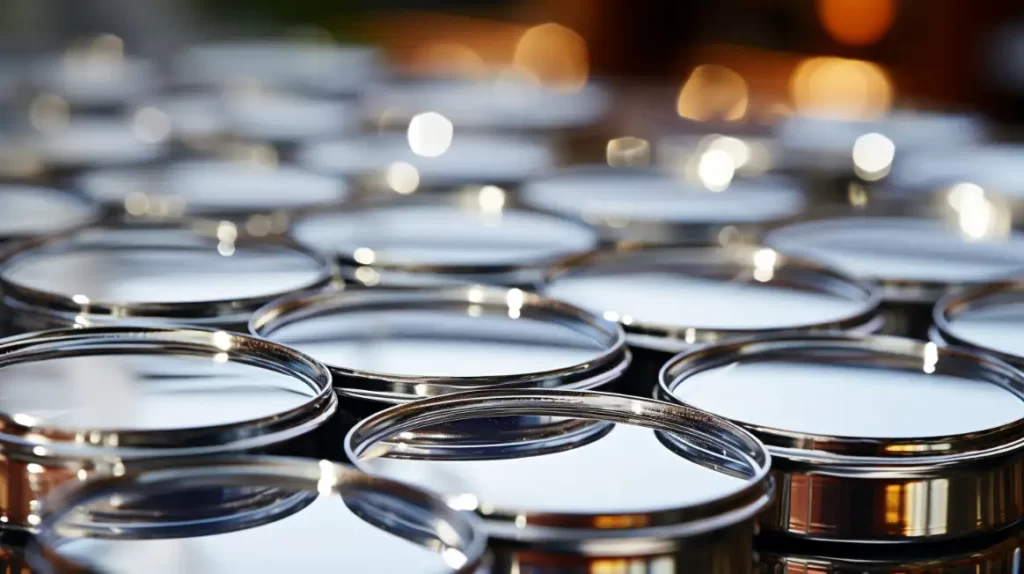
The Future of Surface Finishes
Surface finishes play a part in the fast-paced evolution of our world. We are the industry’s torchbearers, leading the charge for innovation while embracing sustainable practices. What is the future of surface finishes? Let’s take a trip into the future.
Technological Advancements
The marriage between technology and surface finishes opens up a new world of possibilities. Nanotechnology allows us to create surfaces at the molecular scale, resulting in characters that are self-repairing or resistant to bacteria. AI and machine learning are allowing us to streamline quality checks. This ensures that all products that leave our facility meet the highest standards. Augmented Reality and Virtual Reality are also changing how clients, like Jack Garcia, can customize and visualize finishes before production begins. Dear reader, the future is not only bright, it’s also revolutionary.
Trends in Green Manufacturing
Sustainability is not just a buzzword. It’s the future. Green manufacturing practices for surface finishes have become more popular as global awareness of the environment increases. Bio-based paints, made from renewable materials, have grown in popularity. Water-based coatings are also gaining popularity, emitting significantly less volatile organic compounds (VOCs) than their solvent-based counterparts. Our commitment to the environment at Shengen is not just a statement but something we do every day, adopting and advocating green manufacturing trends.
Case studies: Successes & Failures in Surface Finishes
It is essential to learn from both successes and failures. We’ll look at a few notable case studies.
Architectural Marvels & Their Surface Techniques
Take the Petronas Towers, a gleaming structure in Kuala Lumpur. The surface finish of the towers, a play between stainless steel and clear glass, is for more than just aesthetic reasons. This intelligent choice reflects the city’s heritage while providing durability in Malaysia’s tropical weather. This combination of beauty and function shows how a thoughtfully designed surface can transform a structure into a global icon.
Product recalls due to poor surface finish.
The tech sector experienced a significant product recall a few years ago due to a poor surface finish—the metal casing of a popular smartphone model rusted after only a few months. Investigations revealed a surface finish that was not durable enough to withstand everyday wear, resulting in massive financial and brand losses.
Tips and Tricks for DIY Enthusiasts
It’s a thrill to finish projects by hand. While we are an industrial company at Shengen, we appreciate and understand DIY enthusiasts’ passion for their projects. Our shared passion for craft inspires us to offer some tips and tricks on finishing surfaces at home.
Easy and Safe Surface Finishing Techniques for Home
Safety first: Always prioritize safety before you jump in. Wear safety goggles and gloves if you are working with solvents or chemicals.
- Hand-sanding:Start with coarse sandpaper for wood or certain metals. Gradually move up to finer grits. This technique helps remove imperfections and prepare surfaces for finishing.
- Wipe On Finishes:You can apply oils or polyurethane using a cloth. These products are perfect for DIY projects and give wood a protective, lustrous finish.
- Natural finishes:Choose eco-friendly products like beeswax and linseed oils. They are safer to use and give surfaces a genuine, warm glow.
Checklist for Tools and Materials
Each artisan understands the importance of having the right tools. Here is a checklist to help you get started.
- Sandpapers in Various Grits:From coarse (60 to 80 grit) up to fine (220 grit).
- Finishing brushes:Make sure they are lint-free to prevent leaving residue behind.
- Safety Equipment:Wear gloves and goggles. If you work with solvents, you should also wear a mask.
- Finishing agents:Depending upon your project, you may use wood stain, varnish, or oil.
- Rags or Cloths:Preferably free of lint for application and buffing finish.
Common Pitfalls & How to Avoid Them
Speeding up the Process: Surface Finishing is not just a job, it’s a skill. Give yourself enough time to dry between each coat or stage. Patience is often the key to perfection.
Skip Surface Preparation: While it’s tempting to finish the job, prepping the surface (cleaning, priming, or sanding) is crucial for a long-lasting, flawless finish.
Testing the Finishing Agent: Test your finishing agent before applying it to a large area. You will get the desired result without any unpleasant surprises.
Ignoring safety guidelines: Always read and follow instructions, especially when working with chemicals. It is better to be safe rather than sorry.
Conclusion
The surface finish is an essential factor in sheet metal fabrication. Surface finish is crucial to functionality, aesthetics, and durability. We at Shengen understand this. We are committed to excellence in all aspects of our business. When you partner with Shengen, you will receive the best sheet metal fabrication service. We appreciate you choosing Shengen to be your partner. We are here to impress you, serve your needs, and maintain long-lasting, productive collaborations.
Do you need a reliable sheet metal parts manufacturer? Shengen is the place to go. We specialize in sheet metal laser cutting, bending, surface finish, and sheet metal welding. We place a high priority on establishing trust, maintaining standards of quality, providing competitive prices, and guaranteeing timely delivery. Reach out to Shengen Today and seek help from professionals!
FAQs:
Why is surface finish so important for mechanical components?
Surface finish is essential in mechanical components because of several factors:
- Friction Control: A smoother surface can reduce friction and move mechanical parts more efficiently. This will minimize wear.
- Fit and Tolerance: Precision surfaces ensure that components fit together in the intended way while maintaining tight tolerances for high-performance machinery.
- Protection: Surface finishes act as barriers to protect members from environmental factors such as moisture, which can cause corrosion.
Does surface finish have an impact on the life expectancy of a product?
The surface finish of a product can have a significant impact on its lifespan. Here’s how:
- Protect against Elements: A good finish will resist rust, corrosion, and UV rays.
- Resistance To Mechanical Wear: Product surfaces with the right finish can withstand everyday wear and tear, ensuring they continue functioning at their best for longer.
- Aesthetic Durability: Beyond function, a good finishing ensures that products stay visually appealing with time. They maintain their shine, color, and texture.
What are the eco-friendly alternatives for traditional surface finishing?
Absolutely! The industry is changing rapidly to adopt eco-friendly practices.
- Water-Based Coatings: They emit less VOCs than traditional solvent-based coatings.
- Biobased Coatings: Made of renewable resources, they are both environmentally friendly and sustainable.
- Electrolytic processes: Techniques such as electroplating are possible with less toxic chemicals.
More Resources:
Water-based coating – Source: Cjpaintspraying
Mechanical Surface Finishes – Source: Lnf-wiki
Surface roughness measurement techniques – Source: AZOM
Hey, I'm Kevin Lee

For the past 10 years, I’ve been immersed in various forms of sheet metal fabrication, sharing cool insights here from my experiences across diverse workshops.
Get in touch

Kevin Lee
I have over ten years of professional experience in sheet metal fabrication, specializing in laser cutting, bending, welding, and surface treatment techniques. As the Technical Director at Shengen, I am committed to solving complex manufacturing challenges and driving innovation and quality in each project.

